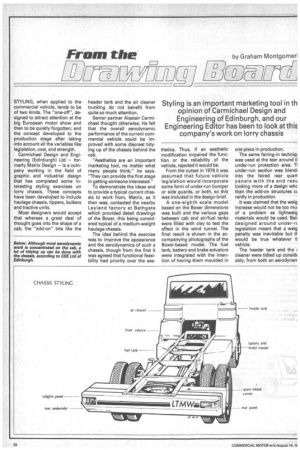STYLING, when applied to the commercial vehicle, tends to be
Page 40

Page 41

If you've noticed an error in this article please click here to report it so we can fix it.
of two kinds. The "one-off", designed to attract attention at the big European motor show and then to be quietly forgotten; and the concept developed to the production stage after taking into account all the variables like legislation, cost, and strength.
Carmichael Design and Engineering (Edinburgh) Ltd — formerly Matrix Design — is a company working in the field of graphic and industrial design that has completed some interesting styling exercises on lorry chassis. These concepts have been develobed to include haulage chassis, tippers, bulkers and tractive units.
Most designers would accept that whereas a great deal of thought goes into the shape of a cab, the "add-on" bits like the header tank and the air cleaner trunking do not benefit from quite so much attention.
Senior partner Alastair Carmichael thought otherwise. He felt that the overall aerodynamic performance of the current commercial vehicle could be improved with some discreet tidying up of the chassis behind the cab.
"Aesthetics are an important marketing tool, no matter what many people think," he says. "They can provide the first stage in getting someone interested."
To demonstrate the ideas and to provide a typical current chassis to work from, Matrix, as it then was, contacted the nearby Leyland factory at Bathgate which provided detail drawings of the Boxer, this being considered typical of a medium-weight haulage chassis.
The idea behind the exercise was to improve the appearance and the aerodynamics of such a chassis, though from the first it was agreed that functional feasibility had priority over the aes thetics. Thus, if an aesthetic modification impaired the function or the reliability of the vehicle, rejected it would be.
From the outset in '1979 it was assumed that future vehicle legislation would incorporate some form of under-run bumper or side guards, or both, so this was included in the design brief.
A one-eighth scale model based on the Boxer dimensions was built and the various gaps between cab and air/fuel tanks were filled with clay to test the effect in the wind tunnel. The final result is shown in the accompanying photographs of the Boxer-based model. The fuel tank, battery and brake actuators were integrated with the intention of having them moulded in one piece in production.
The same fairing-in techniqi was used at the tear around tl under-run protection area. 11 under-run section was blendi into the faired rear quart panels with the end resu looking more of a design whc than the add-on structures ct rently in production.
It was claimed that the weig increase would not be too mul of a problem as lightweig materials would be used. Beir designed around under-ri legislation meant that a weig penalty was inevitable but tt would be true whatever ti vehicle.
The header tank and the cleaner were tidied up consich ably, from both an aerodynarr
aesthetic point of view. One ssible problem with the nmetry of the two compoits is that most air cleaners c:le for this size of vehicle (and Boxer is no exception) tend be circular and thus the CDE Ogn concept might require a ijor switch in purchasing licy, which would contrast h the areas where the sten-d components could be re 'rouble can arise, however, are components have been .ouded with panels, as fitters an forget to put them back. 3 sound-cladding panels fitted lund the engines of several of current middleweights give Dd examples of this. Alastair rmichael was very conscious this: "We won't spend money parts which could be carded in service. All our shiding is part of the structure." rte ideas tried out in using the
Boxer as a base were extended to other vehicles. With a typical tractive unit, for example, the whole of the wheelbase could be faired-in between front and rear mudguards.
Another interesting project to come from the drawing board of CDE Ltd was the Elec Trek. As the sketch shows, the cab's looks break with traditipn. Safety, ergonomics and maximum visibility were priorities.
It is a walk-through cab which has sliding doors (as does the MAN Jumbo heavy haulage model) and would be fitted with twin bunks, sink and water supply and microwave oven. There would be ample storage space.
The cab is constructed of Cycolac ABS panels fastened to a welded steeel frame incorporating a roll cage and underrider. The Cycolac panels are curved where possible and have ribs moulded in to increase the stiffness.
Cycolac was chosen because it is light, tough and non-corrosive. Another important attribute is that it can be moulded into intricate detail with an attractive finish. For the Elec Trek concept, the cab would be coated with a flexible polyurethane paint.
As with the ERF cab structure, the claim is made for Elec Trek that damaged panels can be replaced easily and at low cost.
The chassis styling exercise has had a useful spin off for the Edinburgh-based design team. A bodybuilder from California had seen some of Alistair's work when he visited the USA. Their views coincided in that both agreed that current heavy lorry chassis were "really messy" and would benefit from the addition of panels to tidy up the whole image.
This has progressed to the stage where the first pre-production prototype will be on the road in the USA by the middle of next year. The design is intended more for the longdistance (the US definition) operator and is being sold as a concept to be adopted to individual makes of chassis rather than as a complete package.














































